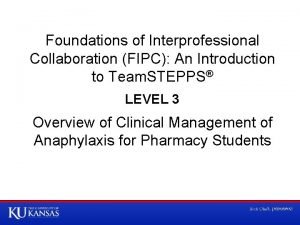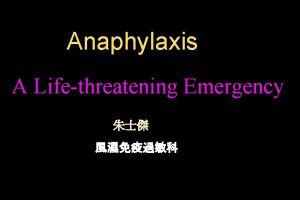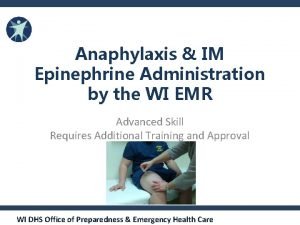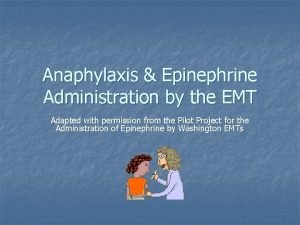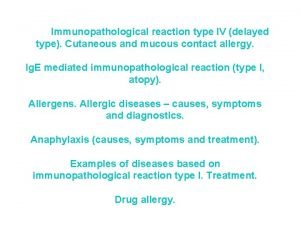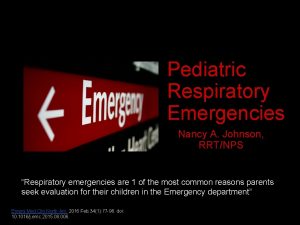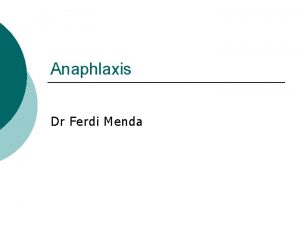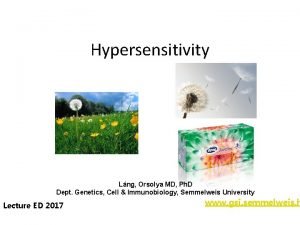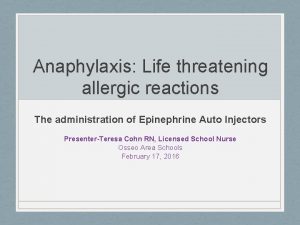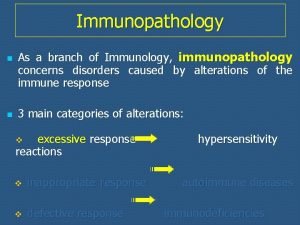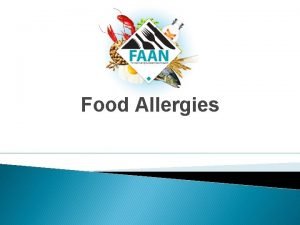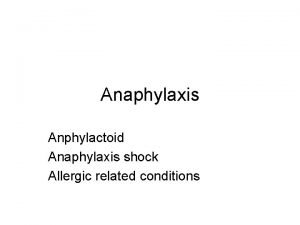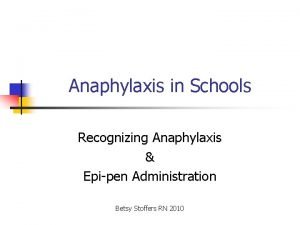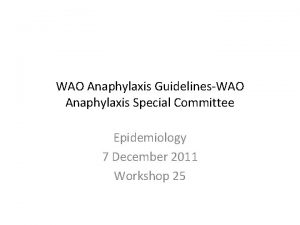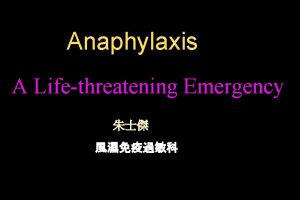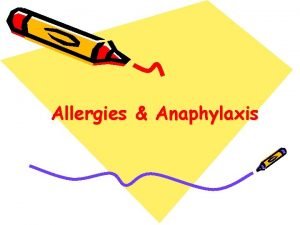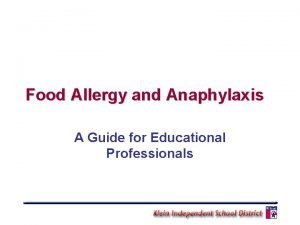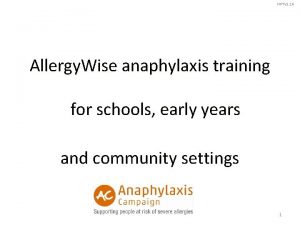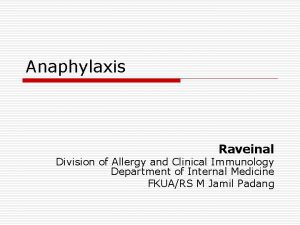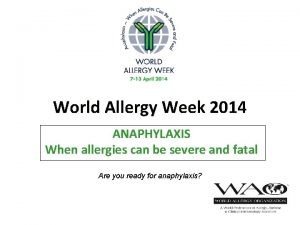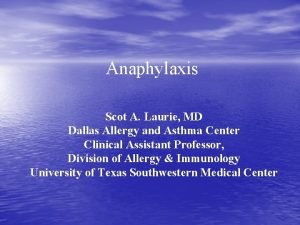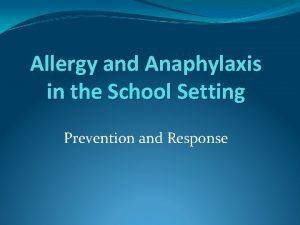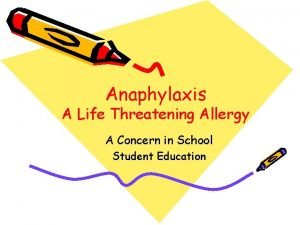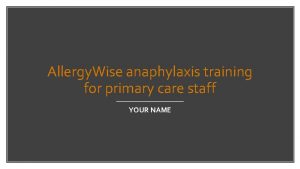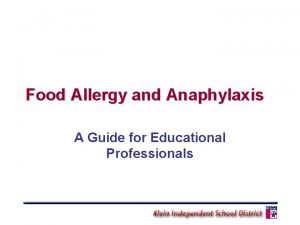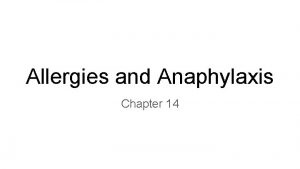Agenda What is Anaphylaxis How to avoid allergy




















- Slides: 20

Agenda ● What is Anaphylaxis? ● How to avoid allergy triggers ● How to recognize signs and symptoms ● How to respond if a student or staff member has an anaphylactic reaction or seizure

ANAPHYLAXIS Awareness, Avoidance, Recognition and Response Nichole Pinto, RN

AWARENESS • • • It is a serious allergic reaction that can cause death. It can affect two or more systems in the body at the same time. It can occur within a few seconds to minutes to hours after exposure to an allergen. It can re-occur up to four hours after treatment. It is a medical emergency that requires medical treatment and follow up with a health care provider specializing in allergies.

Causes: Allergens that can cause Anaphylaxis include foods, insect stings, latex and medications.

Food Allergy: Any food can trigger an anaphylactic reaction in the body. The top eight most common foods: Peanuts, tree nuts (walnut, cashew pecan ect. ), shellfish, milk, wheat, and soy.

Insect Sting Allergy: An allergy to the venom of a stinging or biting insect including bees, hornets, yellow jackets, wasps and fire ants.

Latex Allergy: Natural rubber products that can include but are not limited to: Latex gloves, balloons, balls and gym equipment.

Avoidance Prevention of exposure to allergen is key. • • • Wash hands when dealing with food. Hand sanitizers are not effective. Ensure allergen safe zones. Use of separate utensils for food preparation. Establish school rules to prevent food sharing during the school day.

Recognition SKIN/SURFACE Signs and Symptoms: • Skin-Hives, skin rashes and/or flushing • Itching/tingling/swelling of the lips, mouth, tongue, throat • Nasal congestion or itchiness, runny nose, sneezing, Itchy, teary, puffy eyes

Recognition BREATHING Signs and Symptoms: • Chest tightness, shortness of breath, wheezing or whistling sound • Change in voice, hoarseness or choking • Repetitive throat clearing

Recognition Signs and symptoms Stomach-Nausea, vomiting, dry heaves Abdominal cramps, or diarrhea Circulation-Dizziness, fainting, loss of consciousness Flushed or pale skin Cyanosis (bluish circle around lips and mouth Mental/Psychological-Changes in the level of awareness A sense of impending doom, crying, anxiety Denial of symptoms or severity

Response Implementation of emergency action plan. In order to implement a child’s emergency care plan a staff person needs to know the symptoms of anaphylaxis, how to give the epinephrine auto-injector and other necessary medication, and how to activate emergency medical services. (911) There should be no delay in the administration of epinephrine. All students will require the help of others, regardless of whether they are capable of epinephrine self-administration. The severity of the reaction may hamper their attempt to self inject. Adult supervision is mandatory.

Response ● Epi. Pen Injection Procedure: ● Remove the Epi. Pen device from its protective container ● Pull off gray safety cap from the fatter end of the device (this “arms” the unit ready for use). ● Place black tip on outer thigh. The Epi. Pen is designed so it can be injected through clothing. ● Hold the Epi. Pen in your fist with clenched fingers wrapped around it. ● Push Epi. Pen auto-injector against thigh until unit activates (until a loud “click” is heard) and then hold in place 10 seconds. ● Remove the pen from the thigh; be careful with the needle that will now be projecting from the Epi. Pen when you dispose of the device. ● Massage the injection site to increase epinephrine absorption. There may be some slight bleeding at the injection site. (Apply firm pressure with a cloth, tissue, clean handkerchief or bandage). ● Replace Epi. Pen into original container with exposed needle pointing downward into container.

Response ● Assist student to lying position ● Call 911 and stay with the student until EMS arrives: ● Record the time that the Epi. Pen was given on the Emergency Action Plan and give EMS a through report. ● Give EMS the used Epi. Pen and the Emergency Action Plan.

First Aid for generalized tonic-clonic seizures • Ease the person to the floor. • Turn the person gently onto one side. This will help the person breathe • . Clear the area around the person of anything hard or sharp. This can prevent injury. • Put something soft and flat, like a folded jacket, under his or head. • Remove eyeglasses. • Loosen ties or anything around the neck that may make it hard to breathe. • Time the seizure. • Call 911.

First Aid for any type of seizure ● Stay with the person until the seizure ends and he or she is fully awake. After it ends, help the person sit in a safe place. Once they are alert and able to communicate, tell them what happened in very simple terms. ● Comfort the person and speak calmly. ● Check to see if the person is wearing a medical bracelet or other emergency information. ● Keep yourself and other people calm.

Call 911 if any of these things happen ● The seizure lasts longer than 5 minutes. ● The person has another seizure soon after the first one. ● The person is hurt during the seizure. ● The seizure happens in water. ● The person has a health condition like diabetes, heart disease, or is pregnant.

Staff at the school that are trained in first aid care and CPR Ms. Cordeiro Mr. Pestonit Mr. Lafreniere Mrs. Pinto Mr. Miranda Ms. A Mr. Rosenbaum Ms. Larner Mr. Morel Mr. Chevalier

First Aid bag locations and Epi. Pen locations Main Office-Epi. Pen Discipline Room-Epi. Pen Health Room/Health Music Room 8 th Grade Science Counseling and Support 6 th Grade ELA Room 7 th Grade Science Room 7 th Grade Humanities Room Nurse’s Office-2 Epi. Pens

Additional resource http: //www. foodallergy. org/
 Ig
Ig Brighton collaboration level 1
Brighton collaboration level 1 Interprofessional care for anaphylaxis
Interprofessional care for anaphylaxis Anaphylactoid vs anaphylaxis
Anaphylactoid vs anaphylaxis Anaphylaxis treatment
Anaphylaxis treatment Lateral thigh injection site
Lateral thigh injection site Anaphylaxis photos
Anaphylaxis photos Anaphylaxis
Anaphylaxis Reaction
Reaction Anaphylaxis
Anaphylaxis Angioedema anaphylaxis
Angioedema anaphylaxis Anaphlaxis
Anaphlaxis Nap 6 summary
Nap 6 summary Hypersensitivity
Hypersensitivity Anaphylaxis photos
Anaphylaxis photos Hypersensitivity types examples
Hypersensitivity types examples Allergist delta dental
Allergist delta dental Nap 6 recommendations
Nap 6 recommendations Anaphylaxis onset
Anaphylaxis onset Agenda sistemica y agenda institucional
Agenda sistemica y agenda institucional Icd 10 code for seasonal allergies
Icd 10 code for seasonal allergies


